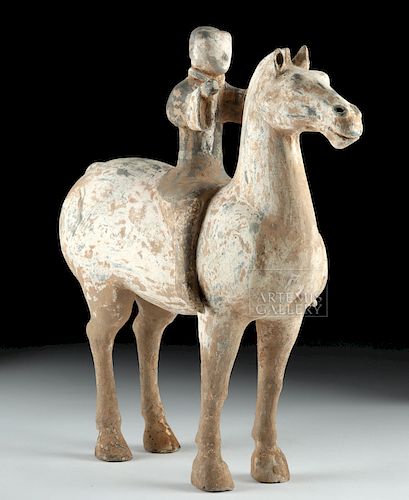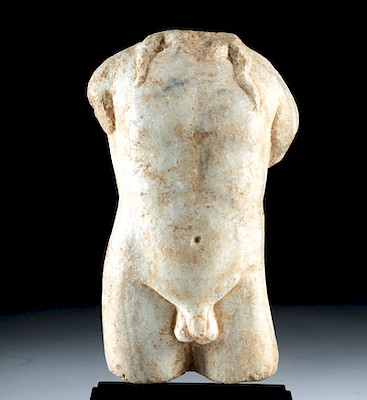Chinese Han Dynasty Pottery Horse and Rider w/ TL
Lot 92
About Seller
Artemis Gallery
686 S Taylor Ave, Ste 106
Louisville, CO 80027
United States
Selling antiquities, ancient and ethnographic art online since 1993, Artemis Gallery specializes in Classical Antiquities (Egyptian, Greek, Roman, Near Eastern), Asian, Pre-Columbian, African / Tribal / Oceanographic art. Our extensive inventory includes pottery, stone, metal, wood, glass and textil...Read more
Categories
Estimate:
$2,000 - $3,000
Absentee vs Live bid
Two ways to bid:
- Leave a max absentee bid and the platform will bid on your behalf up to your maximum bid during the live auction.
- Bid live during the auction and your bids will be submitted real-time to the auctioneer.
Bid Increments
| Price | Bid Increment |
|---|---|
| $0 | $25 |
| $300 | $50 |
| $1,000 | $100 |
| $2,000 | $250 |
| $5,000 | $500 |
| $10,000 | $1,000 |
| $20,000 | $2,500 |
| $50,000 | $5,000 |
| $100,000 | $10,000 |
| $200,000 | $20,000 |
About Auction
By Artemis Gallery
Dec 5, 2018
Set Reminder
2018-12-05 10:00:00
2018-12-05 10:00:00
America/New_York
Bidsquare
Bidsquare : DAY 1 | Classical Antiquities & Asian Art
https://www.bidsquare.com/auctions/artemis-gallery/day-1-classical-antiquities-asian-art-3698
Day 1 of an important 2-day auction featuring ancient and ethnographic art from around the world. Egyptian, Greek, Roman, Viking, Near Eastern plus Asian Art from China, Japan, Thailand, Vietnam, Burma, India, more. Artemis Gallery info@artemisgallery.com
Day 1 of an important 2-day auction featuring ancient and ethnographic art from around the world. Egyptian, Greek, Roman, Viking, Near Eastern plus Asian Art from China, Japan, Thailand, Vietnam, Burma, India, more. Artemis Gallery info@artemisgallery.com
- Lot Description
East Asia, China, Early Han Dynasty, ca. 206 BCE. A mold-made earthenware horse and rider, finely modeled and covered with generous remains of white, black, and red pigments. During the Han dynasty, the ancients placed such model figures in tombs to ensure a safe journey to the afterlife. Note how the sculptor delineated the details of the rider's clothing and positioned his arms as if holding reins, or possibly a weapon and flag - perforations through the hands confirm this. In addition, the muscular body of his noble steed is carefully rendered as well. Size: 11.75" L x 11.625" H (29.8 cm x 29.5 cm)
According to the curatorial team of the Kimbell Art Museum that which has a similar horse and rider in its collection, "Historical records indicate that when important military officials died, the imperial Han court would give them elaborate funerals, including a full military cortege." (https://www.kimbellart.org/collection-object/horse-and-rider) Hence, this horse and rider was most likely originally part of a funerary entourage comprised of soldiers and cavalrymen created to honor a deceased official.
Tomb attendants like this one are part of a class of artifacts called mingqi - sometimes known as "spirit utensils" or "vessels for ghosts". They became popular in the Han Dynasty and would persist for several centuries. Alongside figures like this one were musicians, athletes, animals, structures… Even though they were mass produced, mingqi of the Han Dynasty often show a high level of detail and naturalism. These were designed to assist the po, the part of the soul of the deceased that remained underground with the body while the hun, the other part of the soul, ascended. Caring for the po seems to have taken on a new level of meaning in the Han period, with more elaborate rituals and tomb construction arising.
A Han Dynasty pottery equestrian figure sold at Christie's "The Art of China: Online Winter Sale" (2018, lot 61) for $6,250 - https://onlineonly.christies.com/s/art-china-online-winter-sale/painted-grey-pottery-figure-equestrian-61/51079
See a very similar Han Dynasty Horse and Rider at the Kimbell Art Museum - https://www.kimbellart.org/collection-object/horse-and-rider. The Kimbell curatorial team's description is certainly applicable to this example. They write, " As with much Western Han sculpture, the artist has here focused attention on the figures'’ heads. That of the horse is boldly sculpted and precisely rendered, suggesting the physical attributes of the Samanthian breed from Xinjiang province in Central Asia, prized by the Chinese for its superior strength and speed. The rider’s face is characteristic of the period, with simple and abbreviated, yet naturally modeled, features. In both figures, the strong contours help to define a sense of volume and mass, enhanced by the addition of colorful pigments, which delineate the rider’s costume and the horse’s saddle and harness."
This piece has been tested using thermoluminescence (TL) analysis and has been found to be ancient and of the period stated. A full report will accompany purchase.
Provenance: ex-private North Hills, California, USA collection, acquired in the mid-1990s at Tomlinson Galleries in Bangkok, Thailand. Tomlinson Galleries, among the premier galleries in Asia, has multiple galleries throughout Asia including Bangkok, Singapore, and Malaysia.
All items legal to buy/sell under U.S. Statute covering cultural patrimony Code 2600, CHAPTER 14, and are guaranteed to be as described or your money back.
A Certificate of Authenticity will accompany all winning bids.
We ship worldwide and handle all shipping in-house for your convenience.
#136762Repairs to horse's legs. Rider's head reattached. Expected surface wear with some abrasions commensurate with age, but nice remains of pigment. Horse legs and rider's head reattached. TL hole beneath one hoof.Condition
- Shipping Info
-
All shipping is handled in-house for your convenience. Your invoice from Artemis Gallery will include shipping calculation instructions. If in doubt, please inquire BEFORE bidding for estimated shipping costs for individual items.
-
- Buyer's Premium



 EUR
EUR CAD
CAD AUD
AUD GBP
GBP MXN
MXN HKD
HKD CNY
CNY MYR
MYR SEK
SEK SGD
SGD CHF
CHF THB
THB














